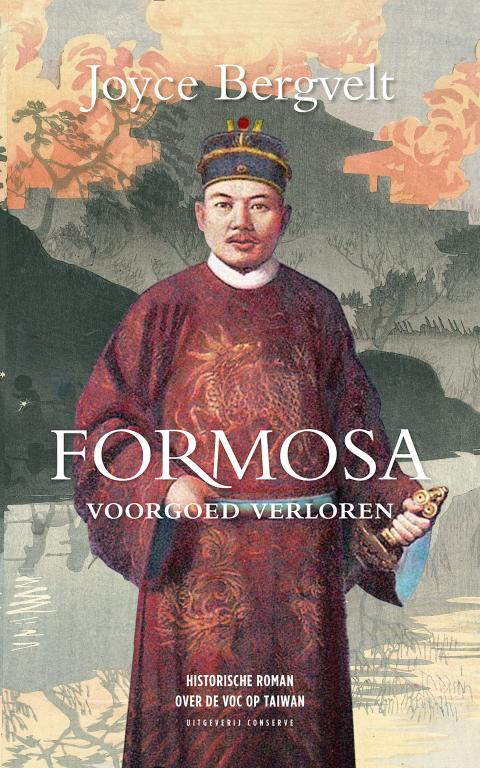It is rare that writers in other nations write a book about the history of Dutch and Spanish rule in Taiwan, with only a few foreign scholars — Leonard Blusse at Leiden University, Tonio Andrade at Emory University, or Jose Eugenio Borao Mateo at National Taiwan University — focusing on the era.
So it is thus quite remarkable that in The Netherlands recently, two writers each published a novel (in Dutch) about events in Taiwan during the period of Dutch rule, from 1624 to 1662. The first is Formosa voorgoed verloren (Formosa lost forever) by Joyce Bergvelt, and the second is Niet zonder tranen; het strijdbare leven van Arnoldus Winsemius (Not without tears, the combative life of Arnoldus Winsemius) by Pieter Winsemius.
Bergvelt became interested in the nation’s history in the early 1980s, when her father served as an executive with the Philips company in Taiwan, and she decided to join her parents and attended National Taiwan Normal University for a year. She became fascinated by the island’s history and wrote a thesis about it during her later studies in the UK. Out of her scholarly work evolved a novel, based on historical facts, to which she added her imagination in order to arrive at a fascinating read, juxtaposing the life of Ming-dynasty warlord and pirate Cheng Cheng-kung (鄭成功, also known as Koxinga) with those of his adversaries on the Dutch side, in particular Swedish-born Frederick Coyett, the last Dutch East India Company governor of Formosa.

Winsemius came to writing his work from a very different background. He served as a minister for urban planning and environment in the Dutch government in the 1980s, and both before and after worked for the consultant company McKinsey. In his free time and after his retirement he was an avid researcher into his family history, and at some point became intrigued by a distant ancestor who was educated as a church minister at Leiden University in the early 1650s, and who at the young age of 22 became a missionary in faraway Formosa, making the long trip by ship to the Far East with his young wife and newborn baby.
His curiosity peaked when he ran into an article by a former Dutch diplomat, Jan Vixseboxse, who related that in 1948 in the archives of the Catholic Cathedral in Chinese Nationalist Party (KMT)-controlled Beijing he had discovered a 17th century Bible, which contained a personal diary by Reverend Arnoldus Winsemius. Vixseboxse was able to take a few pictures of key pages, and many years later published an article about it. The archives and the bible were subsequently lost in the chaos that engulfed China during the Cultural Revolution.
Based on this new evidence, and on long hours of research in the archives of the Dutch East India Company from both Batavia and Formosa (which are available at the National Archives in The Hague), Winsemius pieced together a new diary of his ancestor, based on historical facts, to which he added a highly personal interpretation of what happened in the everyday life in the small village a day’s walk from the Dutch fortress Zeelandia (present-day Tainan).

Both works give a fascinating insight into the life and times of the main protagonists. Bergvelt covers Cheng Cheng-kung’s life from his birth in 1624 to a Japanese mother in Nagasaki, through his education and training in China, the betrayal of the Ming cause by his pirate father Cheng Chih-lung (鄭芝龍), his increasingly bitter fight against the newly established Qing dynasty, culminating in his escape across the Taiwan Strait where he laid a nine-month siege of Dutch-held Fort Zeelandia, and his short-lived victory over the Dutch: he died less than a year later.
Winsemius presents a moving insight into the passion and dedication of his missionary ancestor, who gives up a comfortable life in the Netherlands, and adjusts to life in far Formosa to spread the gospel among the Aborigines. Life was not easy: his first child and his wife die of tropical diseases, but he remarries and is successful in attracting local converts to Christianity. The book presents a very sensitive and humoristic account of the interactions between the pastor and the Aborigines, but also of his struggles with bureaucratic wrangling in both state and church in 17th century Formosa.
The life of the young pastor comes to an abrupt end after Cheng Cheng-kung and his troops arrive, and start their siege of Fort Zeelandia. Unfortunately, pastor Arnoldus Winsemius is among about 500 Dutch teachers, pastors, traders and local administrators living dispersed in approximately 40 villages around the fort, not protected by the fort’s walls and big cannons.
Initially, Cheng Cheng-kung allows them some room for maneuver, but after a major battle in mid-September 1661 in which Dutch ships bombard Cheng Cheng-kung’s troops and encampment, he takes revenge on the hapless civilians, has the teachers and pastors rounded up, torturing them by cutting off their ears, noses and hands, and eventually beheading them.
The siege of the fort would continue for four-and-a-half months, until early February 1662, when governor Coyett finally had to surrender, and was allowed to leave for Batavia with the survivors from the fort and surrounding villages. In Batavia, Coyett was court-martialed by his superiors in the East India Company for “losing Formosa” — while they themselves were actually to blame for not sending the much-needed reinforcements Coyett had asked for. He was banned to a small island in the Moluccas, but after 10 years of exile was rehabilitated and returned to the Netherlands, where he wrote a detailed account of the siege ‘t Verwaarloosde Formosa (The Neglected Formosa).
During the past few years, there has been a strong desire in Taiwan to discover the country’s own history, starting from the Aborigines who inhabited the island more than 5,000 years ago. The Dutch period is particularly significant, because it left many written records by Dutch officials, ship captains and missionaries like Winsemius’ ancestor, describing life and customs of the people on the island, and their interaction with the incoming foreigners.
Against this background, the two books are highly valuable contributions to the understanding of life in Taiwan in the 17th century. One hopes that they can be translated into English and even into Chinese, so more people in Taiwan can catch a glimpse of what life was like 400 years ago: actually, the 400th anniversary of the establishment of the Dutch trading post at Fort Zeelandia / Anping is coming up in a few years.
Publication Notes
Formosa voorgoed verloren; historische roman over de VOC op Taiwan (Formosa lost forever; historical novel about the Dutch East India Company in Taiwan)
By Joyce Bergvelt
566 pages
Conserve Publishers, Schoorl, The Netherlands
Hardcopy: The Netherlands
Niet zonder tranen; het strijdbare leven van Arnoldus Winsemius (Not without tears, the combative life of Arnoldus Winsemius)
By Pieter Winsemius
264 pages
Prometheus Publishers
Hardback: Amsterdam

Most heroes are remembered for the battles they fought. Taiwan’s Black Bat Squadron is remembered for flying into Chinese airspace 838 times between 1953 and 1967, and for the 148 men whose sacrifice bought the intelligence that kept Taiwan secure. Two-thirds of the squadron died carrying out missions most people wouldn’t learn about for another 40 years. The squadron lost 15 aircraft and 148 crew members over those 14 years, making it the deadliest unit in Taiwan’s military history by casualty rate. They flew at night, often at low altitudes, straight into some of the most heavily defended airspace in Asia.

Taiwan’s democracy is at risk. Be very alarmed. This is not a drill. The current constitutional crisis progressed slowly, then suddenly. Political tensions, partisan hostility and emotions are all running high right when cool heads and calm negotiation are most needed. Oxford defines brinkmanship as: “The art or practice of pursuing a dangerous policy to the limits of safety before stopping, especially in politics.” It says the term comes from a quote from a 1956 Cold War interview with then-American Secretary of State John Foster Dulles, when he said: ‘The ability to get to the verge without getting into the war is

Like much in the world today, theater has experienced major disruptions over the six years since COVID-19. The pandemic, the war in Ukraine and social media have created a new normal of geopolitical and information uncertainty, and the performing arts are not immune to these effects. “Ten years ago people wanted to come to the theater to engage with important issues, but now the Internet allows them to engage with those issues powerfully and immediately,” said Faith Tan, programming director of the Esplanade in Singapore, speaking last week in Japan. “One reaction to unpredictability has been a renewed emphasis on

Beijing’s ironic, abusive tantrums aimed at Japan since Japanese Prime Minister Sanae Takaichi publicly stated that a Taiwan contingency would be an existential crisis for Japan, have revealed for all the world to see that the People’s Republic of China (PRC) lusts after Okinawa. We all owe Takaichi a debt of thanks for getting the PRC to make that public. The PRC and its netizens, taking their cue from the Chinese Communist Party (CCP), are presenting Okinawa by mirroring the claims about Taiwan. Official PRC propaganda organs began to wax lyrical about Okinawa’s “unsettled status” beginning last month. A Global